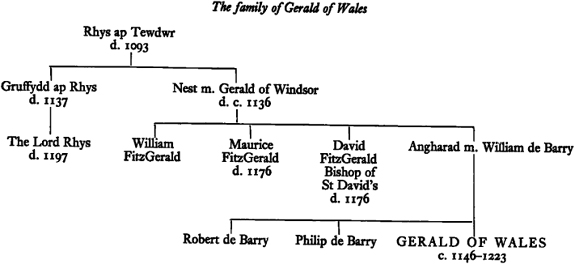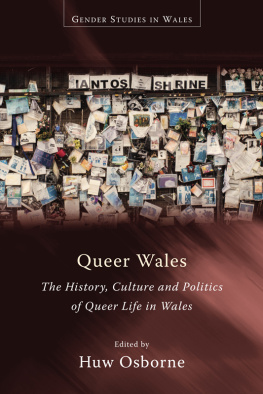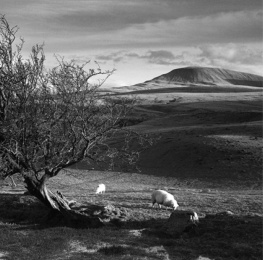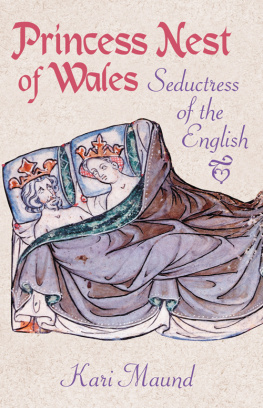GERALD OF WALES
The Journey through Wales
and
The Description of Wales
Translated with an Introduction by
LEWIS THORPE

PENGUIN BOOKS
Published by the Penguin Group
Penguin Books Ltd, 80 Strand, London WC2R 0RL, England
Penguin Group (USA), Inc., 375 Hudson Street, New York, New York 10014, USA
Penguin Books Australia Ltd, 250 Camberwell Road, Camberwell, Victoria 3124, Australia
Penguin Books Canada Ltd, 10 Alcorn Avenue, Toronto, Ontario, Canada M4V 3B2
Penguin Books India (P) Ltd, 11 Community Centre, Panchsheel Park, New Delhi 110 017, India
Penguin Books (NZ) Ltd, Cnr Rosedale and Airborne Roads, Albany, Auckland, New Zealand
Penguin Books (South Africa) (Pty) Ltd, 24 Sturdee Avenue, Rosebank 2196, South Africa
Penguin Books Ltd, Registered Offices: 80 Strand, London WC2R 0RL, England
www.penguin.com
This translation first published 1978
Reissued 2004
21
Copyright the Estate of Lewis Thorpe, 1978
All rights reserved
Except in the United States of America, this book is sold subject
to the condition that it shall not, by way of trade or otherwise, be lent,
re-sold, hired out, or otherwise circulated without the publishers
prior consent in any form of binding or cover other than that in
which it is published and without a similar condition including this
condition being imposed on the subsequent purchaser

THE JOURNEY THROUGH WALES
AND
THE DESCRIPTION OF WALES
ADVISORY EDITOR: BETTY RADICE
GERALD OF WALES, one of the formidable Geraldines, a grandson of Gerald of Windsor and the Princess Nest, was born c. 1145 in Manorbier, Pembrokeshire. He died in obscurity in 1223, possibly in Lincoln. Three parts Norman and one part Welsh, he was one of the most dynamic and colourful churchmen of the twelfth century. His dream was that he might become Bishop of St Davids, be consecrated without having to acknowledge the supremacy of Canterbury and then persuade the Pope to appoint him Archbishop of Wales. For this he fought with great courage and tenacity over the years, refusing four other bishoprics in Ireland and Wales, and preferring to remain Archdeacon of Brecon if he could not realize his grand design. He knew almost everyone worth knowing in his day, kings, popes, Welsh princes, prelates; he argued his case with most of them and he criticized them with some venom in his writings. He wrote seventeen books and planned a number of others, all in Latin. The Journey through Wales and The Description of Wales, obvious counterparts to each other, are among his more amiable works. The first is a travel-diary of a preaching-tour which Archbishop Baldwin and Gerald undertook in 1188 to gain support in Wales for the Third Crusade. The second is a description of the geography of Wales, and of social and economic conditions in that country, in the last years of Henry II. They are invaluable source-books for the history of the twelfth century.
LEWIS THORPE, B.A., L.-s-L., Ph.D., D. de lU., LL.D., F.I.A.L., F.R.S.A., F.R. Hist.S., was Professor of French at Nottingham university from 1958 to 1977. He joined the staff of that university in 1946 after distinguished war service. He was President of the British Branch of the International Arthurian Society, and editor of the societys Bulletin Bibliographique. He was also editor of Nottingham Mediaeval Studies and Nottingham French Studies. He published many articles, and his books include La France guerrire (1945), Le Roman de Laurin, fils de Marques le Snchal (1950), Le Roman de Laurin, text of MS B.N.f.fr. 22548 (i960), Guido Farina, Painter of Verona, 18961957 (1967), with Barbara Reynolds, Einhard the Frank: The Life of Charlemagne (1970), Le Roman de Silence, by Heldris de Cornulle (1972) and The Bayeux Tapestry and the Norman Invasion (1973). He translated Geoffrey of Monmouth: The History of the Kings of Britain, Two Lives of Charlemagne and Gregory of Tours: The History of the Franks for the Penguin Classics. Lewis Thorpe was a member of the M.C.C. He died on 10 October 1977.
My husbands first book, La France guerrire, was published by Penguins in 1945. As he was then in Italy on active service, I had the privilege of correcting the proofs in his absence.
The proofs of this, his last book, arrived a few days after his death. Once again I have performed the same service, with the skilled editorial assistance of Professor Robin Storey, to whom I am most grateful.
The index was made by Brenda Hall, M.A., a registered indexer of the Society of Indexers.
Barbara Reynolds,
University of Nottingham
Gens etenim haec in omni vehemens est intentione. Unde et sicut malis nusquam pejores, sic bonis meliores non reperies.
Descriptio Kambriae, I.18
CONTENTS
INTRODUCTION
1. THE LIFE OF GERALD OF WALES
Giraldus Cambrensis, he had a habit of referring to himself in his writings, and he made a collection of his occasional papers, letters, polemics and poems, so that we do not lack information about him. Everything that he wrote was in Latin.
He was born and apparently spent his childhood in the castle of Manorbier, on the coast of Pembrokeshire in South Wales, and of this delightful spot he paints a nostalgic word-picture in The Journey through Wales. His mother was Angharad, daughter of Nest and granddaughter of Rhys ap Tewdwr, Prince of South Wales. Nests husband was the Norman knight Gerald of Windsor, castellan of Pembroke. It follows that Angharad was only half Welsh and that the blood in Geralds own veins was three quarters Norman. He had two older brothers, Robert and Philip, at least one sister and a half-brother Walter.
One of his mothers older brothers, David FitzGerald, had become Bishop of St Davids in 1148, and from his early youth onwards Gerald was encouraged by his father and his uncle to study and to see himself as a future churchman. As soon as he was old enough to leave his home at Manorbier, he was sent to the Benedictine Abbey of St Peter in Gloucester, where a Frenchman Amelin was Abbot and where his teacher was a monk called Haimo. He approved of the instruction which he received at St Peters and he later described his teacher there as that most learned scholar Master Haimo; It was at St Peters that he began to acquire his mastery of medieval Latin and his extensive knowledge of

classical and later Latin authors. From Gloucester he travelled to Paris for the first of his two lengthy visits.
From the beginning of his career, Gerald gave evidence of reforming zeal. Soon after his return from Paris, he visited Canterbury to complain to Archbishop Richard about the nonpayment of tithes of wool and cheese in the diocese of St Davids. Meanwhile, with his new appointment to give him added authority and with the modest archdeaconry in Llanddew as his base, Gerald pressed on with his reforming activities. The Flemings established by Henry I in Rhos had been granted immunity from the tithes of wool and cheese, but Gerald made sure that their fellow-nationals outside Rhos should pay. He stopped the parish priest of Hay-on-Wye from sharing his benefices with his brother, who was a layman. He made a visitation of the church of Llanbadarn Fawr, despite the fact that his household had been driven off with spears and a shower of arrows. He prevented Adam, Bishop of St Asaph, from appropriating the church of Kerry, which really belonged to the diocese of St Davids.
Next page










